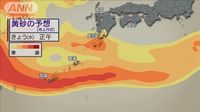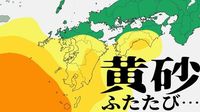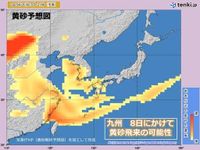As Japan transitions from the Golden Week holidays, residents of western Japan are bracing for the arrival of yellow sand, a phenomenon that often occurs during the spring months. According to the Japan Meteorological Agency, yellow sand is expected to affect areas in Kyushu, Chugoku, and Shikoku from May 7 to May 8, 2025. The agency's "Yellow Sand Analysis Forecast Map" indicates that the shadow of yellow sand has already begun to cover parts of western Japan, including Kyushu and Shikoku, as of the morning of May 7.
Reports suggest that the concentration of yellow sand is expected to be low; however, caution is advised due to potential visibility issues and health impacts. Visibility is projected to drop below 10 kilometers in many areas, with some locations experiencing visibility of less than 5 kilometers. This could lead to disruptions in transportation and exacerbate respiratory conditions for some individuals.
In Okinawa, the local meteorological observatory has also warned of yellow sand arriving on May 7, with similar visibility concerns. The observatory noted that the phenomenon is caused by dust and sand blown from deserts such as the Gobi and Taklamakan, which are then carried by winds across the ocean to Japan. The Okinawa Meteorological Observatory, which ceased visual observations of yellow sand last year, now focuses on providing forecasts and warnings regarding this seasonal occurrence.
Weather conditions across Japan are reportedly improving after the holiday season, with high pressure dominating the weather on May 7. This has resulted in sunny skies across western and eastern Japan, although the threat of yellow sand looms over the region. In the Kanto area, temperatures are expected to rise significantly, reaching up to 24 degrees Celsius in Tokyo, a notable increase from the previous day. Residents are advised to manage their health carefully due to the sharp temperature variations.
As the yellow sand makes its way across Japan, it is essential for individuals to take precautionary measures. Experts recommend wearing masks, drying laundry indoors, and utilizing air purifiers to mitigate the effects of the yellow sand. It is also advisable to wash hands and gargle upon returning home, as these simple actions can help reduce health risks associated with inhaling the fine particles.
The peak of the yellow sand is expected from the morning to noon of May 7, but vigilance is encouraged throughout May 8 as well. The phenomenon is not just a nuisance; it can lead to significant visibility reduction and health concerns, particularly for those with pre-existing respiratory issues.
Looking ahead, the yellow sand is anticipated to clear from Japan by May 9, but another wave is expected to return on May 10, necessitating continued awareness and preparation. The Japan Meteorological Agency has emphasized that while the initial concentration of yellow sand may be low, the potential for adverse effects remains a concern.
As spring progresses, the reasons for the seasonal arrival of yellow sand become clearer. The phenomenon is linked to the condition of the deserts where the dust originates. During spring, the deserts are not covered by vegetation, and rising warm air makes it easier for sand to be lifted into the atmosphere. Additionally, prevailing westerly winds act as a conveyor belt, transporting the yellow sand across the sea to Japan.
With the yellow sand season expected to last through May, residents are encouraged to stay informed about forecasts and take necessary precautions. The Japan Meteorological Agency continues to provide updates and guidance on managing the impacts of yellow sand, emphasizing the importance of public awareness during this time.
In conclusion, as yellow sand descends upon western Japan, residents should remain vigilant and proactive in protecting their health and visibility. The combination of seasonal weather changes and geographic factors contributes to this natural occurrence, reminding us of the intricate connections between our environment and daily life.






